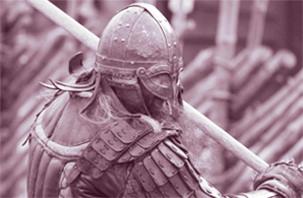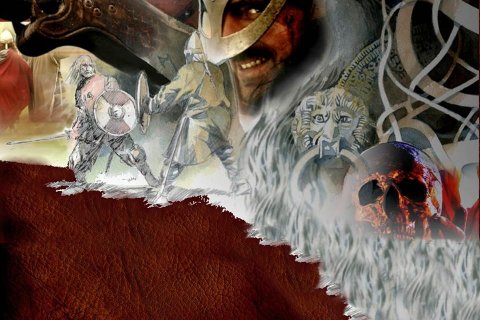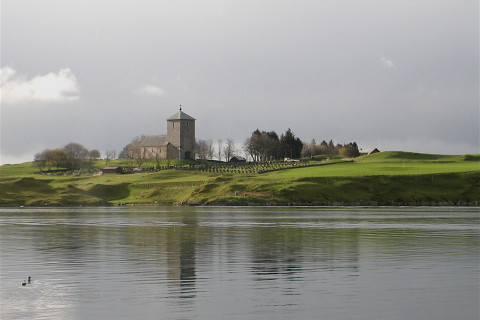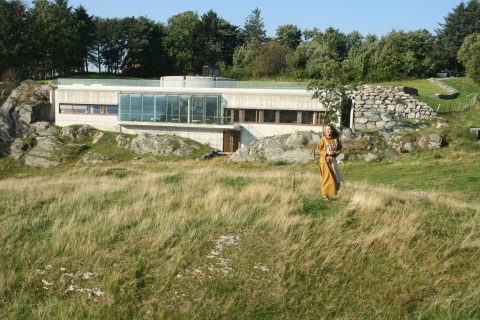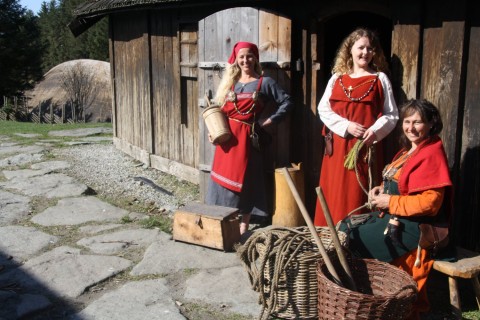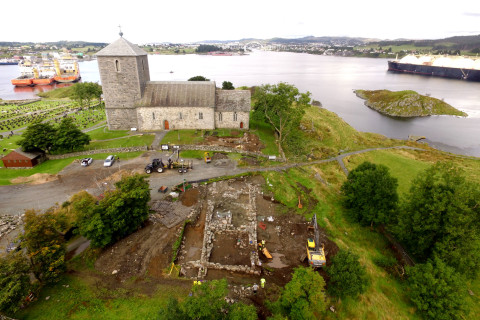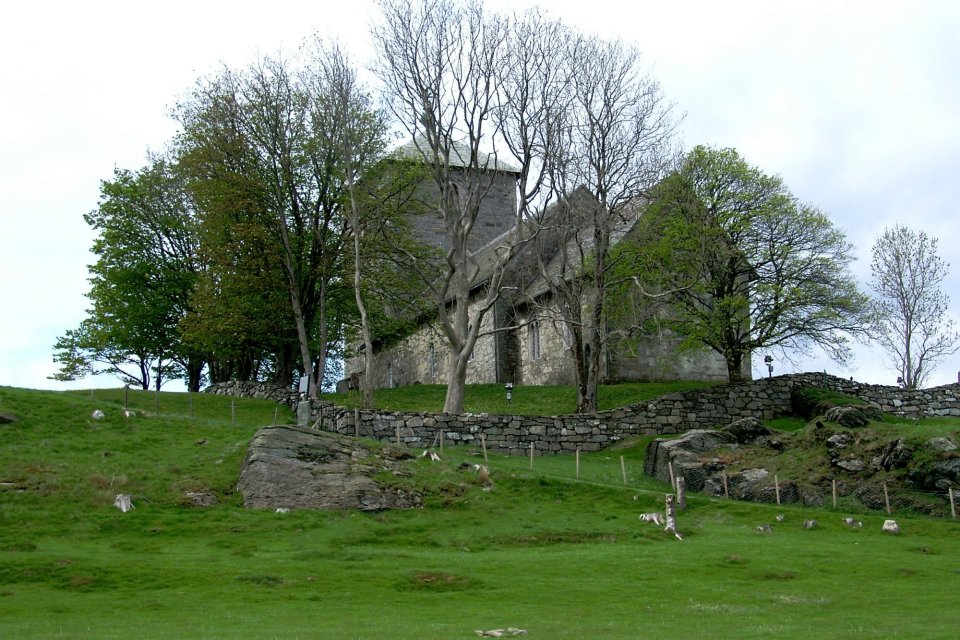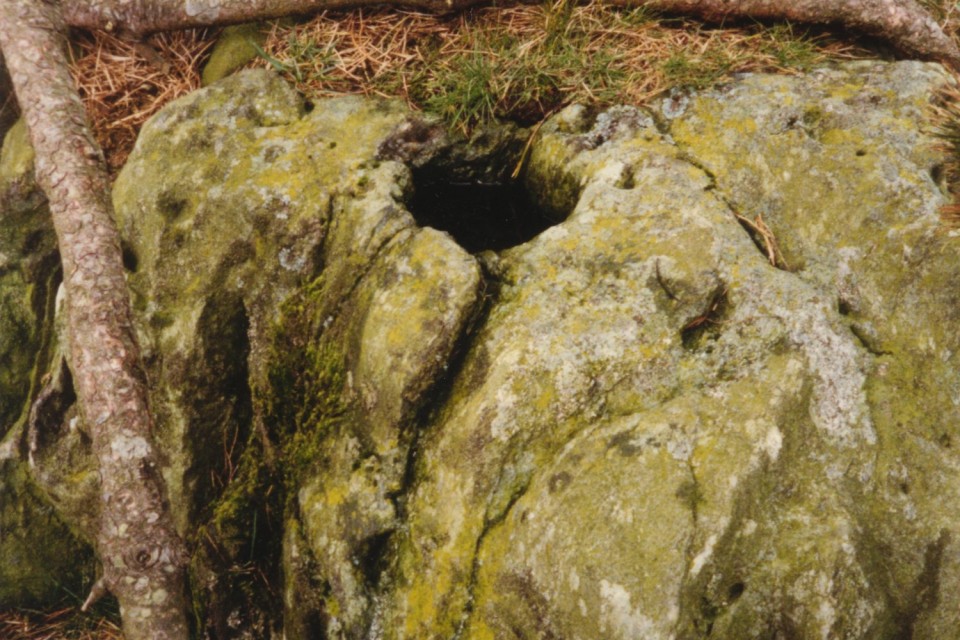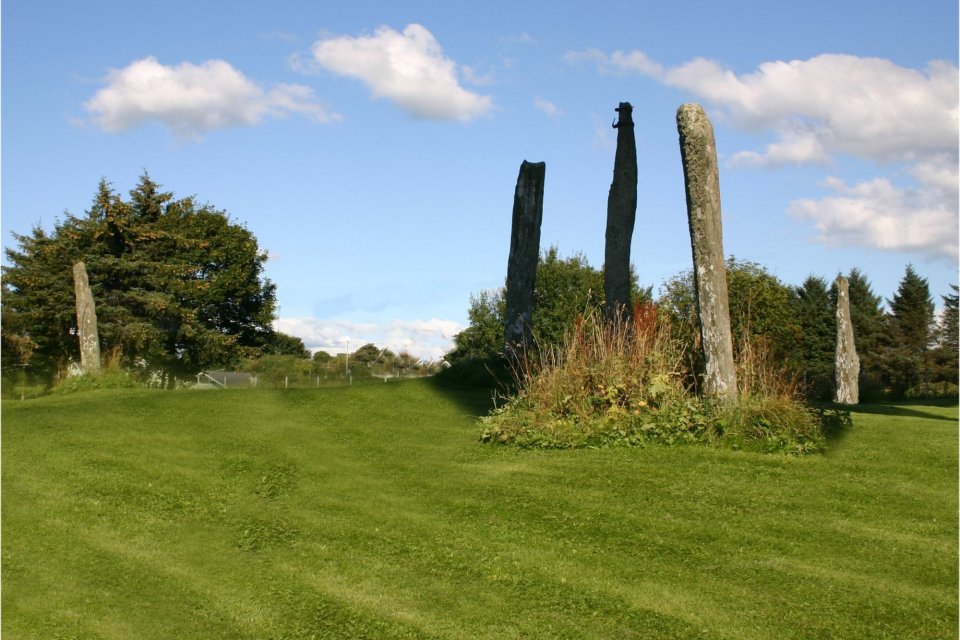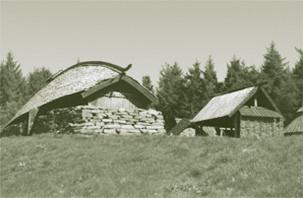St Olaf
Text: Marit Synnøve Vea
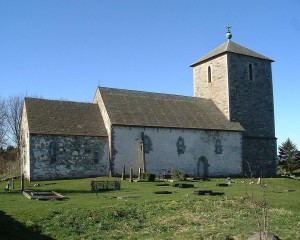
Many pilgrims visited St. Olaf’s church. The pilgrims used the door that faced northwards. Today this door is bricked up. (Photo Ørjan Iversen)
(Óláfr Haraldsson, Óláfr hinn helgi 995 -1030). King of Norway from 1015 – 1028
Olaf (Olav) Haraldsson was the son of Harald Grenske from Ringerike and according to Snorri, Harald Fairhair was his great-great-grandfather. His mother was Åsta Gudbrandsdatter. His father died before Olaf was born and he grew up with his mother and stepfather, Sigurd Syr. Olaf is also known as Olaf the Holy and Saint Olaf. He was also nicknamed Olaf “Digre” (great). In Old Norse, the nickname “Digre” may signify that he was fat or heavily built.
Snorri tells this about Olaf:
“When Olaf Haraldson grew up he was not tall, but middle-sized in height, although very thick, and of good strength. He had light brown hair, and a broad face, which was white and red. He had particularly fine eyes, which were beautiful and piercing, so that one was afraid to look him in the face when he was angry.
Olaf was very expert in all bodily exercises, understood well to handle his bow, and was distinguished particularly in throwing his spear by hand: he was a great swimmer, and very handy, and very exact and knowing in all kinds of smithwork, whether he himself or others made the thing. He was distinct and acute in conversation, and was soon perfect in understanding and strength. He was beloved by his friends and acquaintances, eager in his amusements, and one who always liked to be the first, as it was suitable he should be from his birth and dignity. He was called Olaf the Great.
Olaf and his Viking raids in Europe
Olaf was only 12 years old when he went on Viking raids, first eastwards and then with the Jomsvikings to England where he waged war. They did not succeed in capturing London, but in 1011 they reached Canterbury. Later, Olaf went to Spain and Cádiz and he spent the winter of 1013-14 at the court of Richard II of Normandy
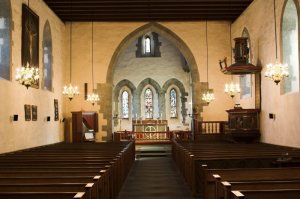
St. Olaf’s Church at Avaldsnes was consecrated to Olaf the Holy. Originally the church had three alters. The main alter was dedicated to St Olaf. Probably the church had also relics related to St Olaf.
Olaf is baptised
Richard and the men of Normandy were Christians and descendants of Danish and Norwegian Vikings and Olaf had himself baptised in Rouen. From Normandy, Olaf set out for England again in 1014, but this time he helped the English King Adelred II to recapture London from the Danes. Legend has it that they destroyed London Bridge and the English nursery rhyme “London Bridge is falling down” is said to be based on this event.
Olaf returns to Norway to rule as king
When Olaf returned to Norway, the earls of Lade were ruling the country on behalf of the Danish king, as they had done since the fall of Olaf Tryggvason at the Battle of Svolder. In addition, there were a number of very powerful chieftains.
Olaf began by taking Earl Erik of Lade prisoner and sending him to England. Olaf then took over as a minor king in his homeland of Oppland. He later conquered Viken and Agder and by the time he reached Trøndelag, he had acquired so much power that the people there hailed him as king at their assembly.
Olaf soon ruled over the whole of Central and Southern Norway and was also proclaimed king of Hålogaland, Northern Norway. He made peace with the king of Sweden and married the Swedish princess Astrid.
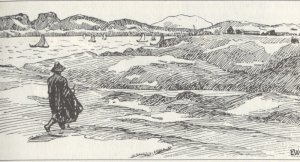
Asbjorn Sigurdsson on his way to the Royal Manor at Avaldsnes. (Ill. E. Werenskiold. Saga of Olaf the Holy)
Olaf had to make peace with the coastal chieftains
But there were still a number of powerful chieftains who held sway along the coast. Among them were Tore (Thorer) Hund from the Bjarkøy clan in Troms and Erling Skjalgsson from Sola. Erling was Olaf Tryggvasson’s brother-in-law and it was said that when Olav Haraldsson came to Norway, Erling was the true ruler of Western Norway, with a territory stretching from Rogaland to Sogn.
The crown must take control of the trade along the coast
Olaf Haraldsson fought to win even greater power. To achieve this, he had to weaken the power of the coastal chieftains. Olaf wanted to take control of Western Norway and the trade along the Norwegian coast. As part of his plan, he dismissed the old steward at Avaldsnes (Augvaldsnes) and appointed Tore Sel (Thorer Sel) as his steward or farm-manager at the royal court.
Olaf prohibits the sale of corn to Northern Norway
In 1022 Olaf forbade the West Norwegians to sell corn to people in the north of the country. This made it difficult for the chieftains in Northern Norway to brew beer and inviting people to banquets as one expected that chieftains should do.
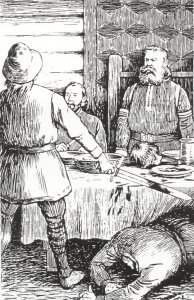
Asbjorn beheads Thorer Sel, so that the head fell upon the table before the king, and the body at his feet, and the table-cloth was soiled with blood from top to bottom. (Ill. Theodor Kittelsen. Saga of Olaf the Holy)
Erling Skjalgsson of Sola ignored the ban and sold corn to his nephew the Northerner Asbjørn Sigurdsson. Erling believed he bypassed the king’s ban because it was his slaves, not Erling himself, who sold the corn to the chieftain of Trondenes.
When Asbjørn sailed his ship home, he had to pass the Royal Manor at Avaldsnes. The kings farm-manager, Tore Sel, then confiscated the cargo of corn that Asbjørn had purchased from his uncle. Tore Sel also confiscated Asbjørn’s beautiful striped sail, and replaced it with an old one. This was a great offence of Asbjørn’s honour.
Asbjørn returns to the Royal Manor at Avaldsnes
A year later, Easter 2013, Asbjørn sailed southward to Avaldsnes, eager to take his revenge. He landed his ship on the west side of the island Karmøy (Kormt) and hid his ship with 90 men on board. Asbjørn advanced secretly and alone towards the royal estate.
When Asbjørn reached a hillock, from which he could see the Royal Manor at Avaldsnes, he saw people in all quarters flocking together by land and by sea. He understood that the king was holding a banquet, and that 90 men were not enough to attack all the king’s followers. Asbjørn decided to sneak into the king’s hall and take his revenge on his own.
In the banqueting hall Asbjørn could hear that Tore Sel boasted about confiscating Asbjørns cargo the year before, and he spoke in a way that departed from the truth. And when Tore Sel told King Olaf that Asbjørn burst into tears as they took his sail, Asbjørn dashed into the hall, drew his sword and beheaded Tore Sel. Sel’s head fell onto the table in front of the king and its blood spurted onto the king’s plate.
King Olaf sentences Asbjørn to death
King Olaf fled into a rage and condemned Asbjørn to death. Skjalg Erlingsson begged for mercy for his cousin, but the king replied that he liked little that someone broke the peace of Easter and used his feet as execution-block.
Since it is Good Friday, the king cannot execute Asbjørn until after Easter. Skjalg, son of Erling Skjalgsson, and some of his faithful men, rowed haistily over the fjord to tell Erling that the king had condemned his nephew to death.
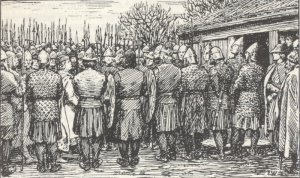
King Olaf walks through the lines of Erling’s men. (Ill. E Werenskiold. Saga of Olaf the Holy)
Erling Skjalsson comes to Avaldsnes with 1500 men
Erling summoned 1500 men who set out for Avaldsnes to save Asbjørn. Erling placed his men in ranks on each side of the church door. When the king came out of the church, he was forced to run the gauntlet between Erling’s men.
Olaf had no other choice but to reconcile himself with Erling and release Asbjørn. The condition was that Asbjorn, who after this event is called Selsbane (Sel’s slayer), should return to Avaldsnes and act as the king’s farm-manager. But Asbjørn did not keep his promise to the the king. Instead he stayed home at Trondenes. (Read more: THE CONFRONTATION BETWEEN KING OLAF AND ERLING SKJALGSSON AT AVALDSNES. EXTRACT FROM HEIMSKRINGLA
Avaldsnes – a royal bastion surrounded by Erling Skjalgsson’s kingdom
The power struggle between Erling and Olaf was also a struggle to gain control over the trade route through the strait of Karmsundet and along the coast. Up until the Viking Age, Avaldsnes played a key role when the chieftains vied for control of “Nordvegen” – the shipping route along the coast of Norway. It was important to gain control of Avaldsnes because whoever controlled the strait of Karmsundet had in effect control over the shipping and trade along the Norwegian coast and thereby over all trade with the Continent.
Due to its strategic location at the core of the shipping fairway, there gradually developed a pressing need for a legal means of safeguarding shipping along the coast. There are indications that Avaldsnes may have been a Libero Portu Regio from as far back as the Late Roman Period (the 3rd century) – a freeport where the king could make sure that potential enemies could, on payment of a fee, pass through or lay anchor with their cargoes.
The nobles living along the coast may have regarded the confiscation of Asbjørn’s cargo of corn as a breach of the king’s duty to safeguard the passage of ships through the strait of Karmsundet.

King Olaf is killed at Stikelstad in 1030. Asjorn’s uncleThorer Hund stricks him with his spear (Ill Halfdan Egedius, Saga of Olaf the Holy)
Olaf Haraldsson becomes Olaf the Holy
The fateful meeting between king Olaf and Erling Skjalgsson at Avaldsnes in 1023 was the cause of much conflict between the clans. Not long afterwards, both Asbjørn and Erling Skjalgsson were killed by men loyal to the king, and finally it lead to Olaf’s death at Stiklestad.
Olaf was forced to flee from Norway in 1028 when Canute the Powerful descended upon the country with 50 warships. Olaf returned home to Norway in 1030 and fought against an army of farmers, led by Thorer Hund, at Stiklestad. Olaf was slain in this battle.
Immediately after Olaf’s death, there was an eclipse of the sun and peculiar things begin to happen with his corpse. Some of Olaf’s blood was placed on a blind man’s eyes and the man’s vision was restored. And when Olaf’s body was exhumed after a year had passed, his hair, beard and nails were seen to have grown. The king was then given the name of St Olaf or Olav the Holy and many pilgrims came to pay homage at Olav’s grave in Nidaros (Trondheim).
St Olaf’s Church at Avaldsnes
When King Håkon Håkonsson built his church at Avaldsnes around 1250, he consecrated it to St Olav, and the church became an important stopping place for pilgrims going to Nidaros. There are still place names and tales around Avaldsnes which remind us of this pilgrim route. Here is also a St Olaf’s Well that the pilgrims used to visit. (Read more about this in Legends about St Olaf.)
Back

